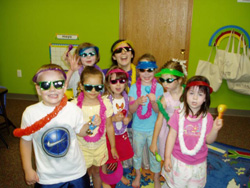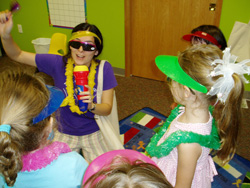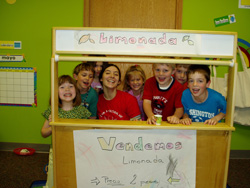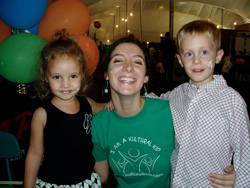Growing up in Concepcion, Chile, Denise Leitch learned to speak the native Spanish language and was immersed in the French language as well. Being bilingual wasn’t strange to her, as it might be for many Americans. Even after just a few months of living in the United States as an exchange student and junior at Morton High School, she was able to speak English fluently. But it was the love of a universally-spoken language that led her to start her Morton business—the language of art.
Now in its second year and with most of its foreign language and art classes full, Kultural Kids is thriving. “One of my true passions has always been art. Through my college education, I was exposed to various activities giving me the tools and knowledge to develop a fun creative arts curriculum for the Kultural Kids Learning Center,” Leitch said. “After graduating from college I worked full time and taught foreign language independently. In little time, I was going to various locations to teach fun foreign language classes to young children. After seeing the growing interest from adults as well as children in my foreign language courses, I decided to create my own fun, full-immersion foreign language and creative arts center. This is how the Kultural Kids Learning Center was created.”
Just one year at Morton High School developed into a love for American culture and education for Leitch, and she decided to apply at Bradley University. After being accepted, she studied early childhood education and psychology and also tutored children. She graduated from Bradley in 2003 with a bachelor’s degree in psychology with a focus on child brain development.
 Combining her multilingual background and the successful immersion programs of her youth, Leitch developed similar foreign language immersion programs at Kultural Kids. Using full immersion, teachers are able to expose children to a fun environment where they learn a foreign language—either French or Spanish—just like they did their native tongue. “As soon as the child walks into our classrooms, the native tongue is left behind and only the targeted foreign language is used,” Leitch said. “After all, full immersion is the way all of us learned our first language. Our style allows children to have fun and enjoy themselves while rapidly learning the targeted foreign language.”
Combining her multilingual background and the successful immersion programs of her youth, Leitch developed similar foreign language immersion programs at Kultural Kids. Using full immersion, teachers are able to expose children to a fun environment where they learn a foreign language—either French or Spanish—just like they did their native tongue. “As soon as the child walks into our classrooms, the native tongue is left behind and only the targeted foreign language is used,” Leitch said. “After all, full immersion is the way all of us learned our first language. Our style allows children to have fun and enjoy themselves while rapidly learning the targeted foreign language.”
Leitch, along with many language experts, believes that full immersion is the best technique to grasp a second language quickly and almost effortlessly. And since children are learning in a friendly environment filled with games, stories and imaginative play, they might not even be aware that education is taking place.
Sooner is better for learning a second language, Leitch says, and she strongly recommends exposing children to a foreign language right after birth. “Currently, it is a great plus to be able to speak more than one language, in the future it will be almost a must. Therefore, it is best to take advantage of the unique ability of a child’s brain to learn a language naturally as early as possible,” Leitch said.
At the Kultural Kids Learning Center, parents can enroll children between the ages of one and 12. “Since our programs are all well-structured to provide the best learning environment for a child, we do not start any sooner, but I sure recommend parents to do so at home,” Leitch said.
 There are three reasons parents consistently give Leitch for wanting their child to learn a second language. The number one reason is educational betterment, followed by cultural understanding and then better communication skills. Leitch said research shows learning a second language can help children become better acclimated with their native tongue and that bilingual children tend to do better than their monolingual peers in various academic subjects, including mathematics and science. But some parents worry that learning a second language will slow a child’s normal language development—in that a bilingual child’s performance in either language may lag behind that of monolingual speakers—a theory Leitch vehemently opposes.
There are three reasons parents consistently give Leitch for wanting their child to learn a second language. The number one reason is educational betterment, followed by cultural understanding and then better communication skills. Leitch said research shows learning a second language can help children become better acclimated with their native tongue and that bilingual children tend to do better than their monolingual peers in various academic subjects, including mathematics and science. But some parents worry that learning a second language will slow a child’s normal language development—in that a bilingual child’s performance in either language may lag behind that of monolingual speakers—a theory Leitch vehemently opposes.
“Before children can speak, their brains are able to encode unique sounds, accents, intonations and more. All of this information shapes and helps develop the infant’s brain and will be used throughout his/her life,” Leitch said. “As the child grows, it becomes increasingly difficult to learn new words, develop new sentence structures and flawlessly imitate new accents. Experts suggest that by age 10, humans have already lost the ability to hear and reproduce new sounds.”
Since children learn at such a rapid rate, it can be very difficult for parents to challenge their learning at home if they are not also versed in the language. Leitch suggests parents try their best to learn the foreign language using full immersion as well. “For many years, children (may) only hear English being spoken at home, and many children tend to refuse to use the foreign language at home from their parents. I would recommend always communicating with children, ask what they learned (in foreign language class) and try to encourage foreign language speech, but do not force them.”
 To help parents understand how much their child is learning, an assessment form is provided at the end of each session. It keeps them informed of the child’s progress and also gives examples of what was covered in the classroom. But parents and caregivers are encouraged to attend programs for the 1-to-3-year-old group. “All of our programs are designed with the child’s needs in mind. Before age three, children have a great capacity for learning, but they are very insecure emotionally. Children at this age need the support of a loved one in order to feel safe and perform their best,” Leitch said. “By age three, children are able to be “separated” from a caregiver and perform their best. Sometimes, at this age, having a caregiver by their side becomes more of a distraction than a learning partner. At Kultural Kids Learning Center we have children transition to our “older group” at age three because we believe that they are ready to be challenged a little more and our caring and trained teachers can offer young children a safe environment.”
To help parents understand how much their child is learning, an assessment form is provided at the end of each session. It keeps them informed of the child’s progress and also gives examples of what was covered in the classroom. But parents and caregivers are encouraged to attend programs for the 1-to-3-year-old group. “All of our programs are designed with the child’s needs in mind. Before age three, children have a great capacity for learning, but they are very insecure emotionally. Children at this age need the support of a loved one in order to feel safe and perform their best,” Leitch said. “By age three, children are able to be “separated” from a caregiver and perform their best. Sometimes, at this age, having a caregiver by their side becomes more of a distraction than a learning partner. At Kultural Kids Learning Center we have children transition to our “older group” at age three because we believe that they are ready to be challenged a little more and our caring and trained teachers can offer young children a safe environment.”
The staff at Kultural Kids consists of Mari Khoury, Bekah Smidt, Sarah Smith and Leitch. Each teacher has either traveled to a foreign country or experienced another culture and has a well-rounded knowledge about art, something Leitch specifically looks for in her instructors. “Kultural Kids instructors are carefully selected for their skills, teaching talents and effectiveness with young children,” Leitch said. “Our foreign language instructors are required to speak the foreign language with authentic accents. In addition, all Kultural Kids instructors share one common goal—to provide a clean, safe and fun environment for children.
In the art programs, children are exposed to different mediums and techniques, experimenting with tempera, fingerpaint, charcoal, watercolors, clay, metal, wood and many other art forms. All of the classes are designed to introduce these mediums in a fun and relaxing environment, allowing children to explore and express themselves freely. In the new Kreative Drama classes, children are able to try out a variety of activities including speech, verbal dynamics, creative movement, dance drama and language development. The advanced curriculum also includes structured improvisation, dialog development, scene starters and mini-scripts. Children actually have a chance to learn all aspects of theater production. And with many hands-on activities in the new Silly Science classes, children can conduct their own (messy) experiments as they delve into the world of science.
 “Children learn best through being actively engaged in a subject— a child becomes actively engaged when he or she is having fun. For this reason we strive to find the perfect mix between the fun and educational elements that exist in both our creative art and foreign language programs,” Leitch said. “By focusing on the activity and the enjoyment of the children, it becomes so much easier to encourage them to learn.”
“Children learn best through being actively engaged in a subject— a child becomes actively engaged when he or she is having fun. For this reason we strive to find the perfect mix between the fun and educational elements that exist in both our creative art and foreign language programs,” Leitch said. “By focusing on the activity and the enjoyment of the children, it becomes so much easier to encourage them to learn.”
Depending on the program, class sizes vary but are kept small—a maximum of eight students in the foreign language classes and five or six students in the creative arts programs—in order to give each child individual attention and provide the best quality of education possible. “Every child is different and she or he learns at a different rate. Within the first four weeks, most children feel comfortable enough to react spontaneously to our activities,” Leitch said. “Through body language they start to show comprehension of the foreign language and its demands.”
On average, after five to six months, most of the children at Kultural Kids show an understanding of a foreign language and many are also able to express themselves in the foreign language. After two years, children can start to show spontaneous speech and major comprehension of a foreign language, Leitch said. “The most rewarding aspect of opening this business is to see the children’s progress,” Leitch said. “I have a child that started in my Spanish foreign language program when she was six years old and now she is nine years old. Last month, she and her family went on a vacation to San Francisco. When they got back, she told me that she was able to understand many people and she was able to communicate and help her family in certain situations. In addition, I have 4-year-olds that attend my creative arts programs and they are able to tell me about primary colors, secondary colors and differentiate between the various types of lines, all thanks to our Learning Center!”
Kultural Kids is looking to invade everyone’s home with educational materials designed to encourage full immersion learning, which should be available to the public by 2008. Registration for classes is currently underway. For more information on Kultural Kids or to register for any of the programs offered, visit www.kulturalkids.com or call 266-9624. TPW


